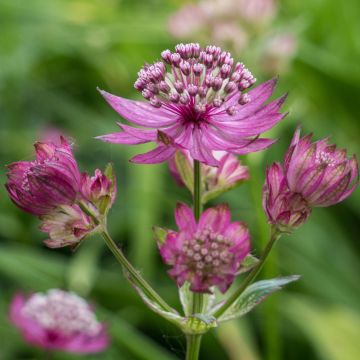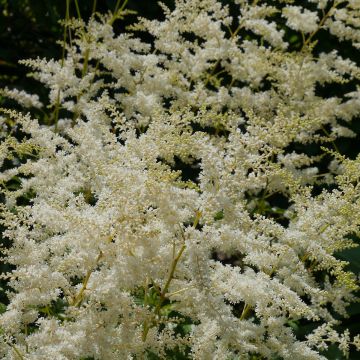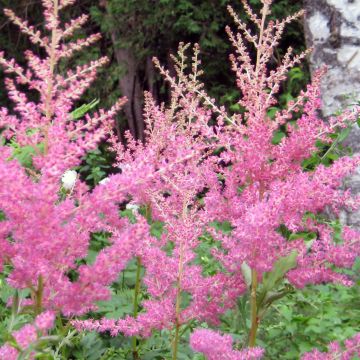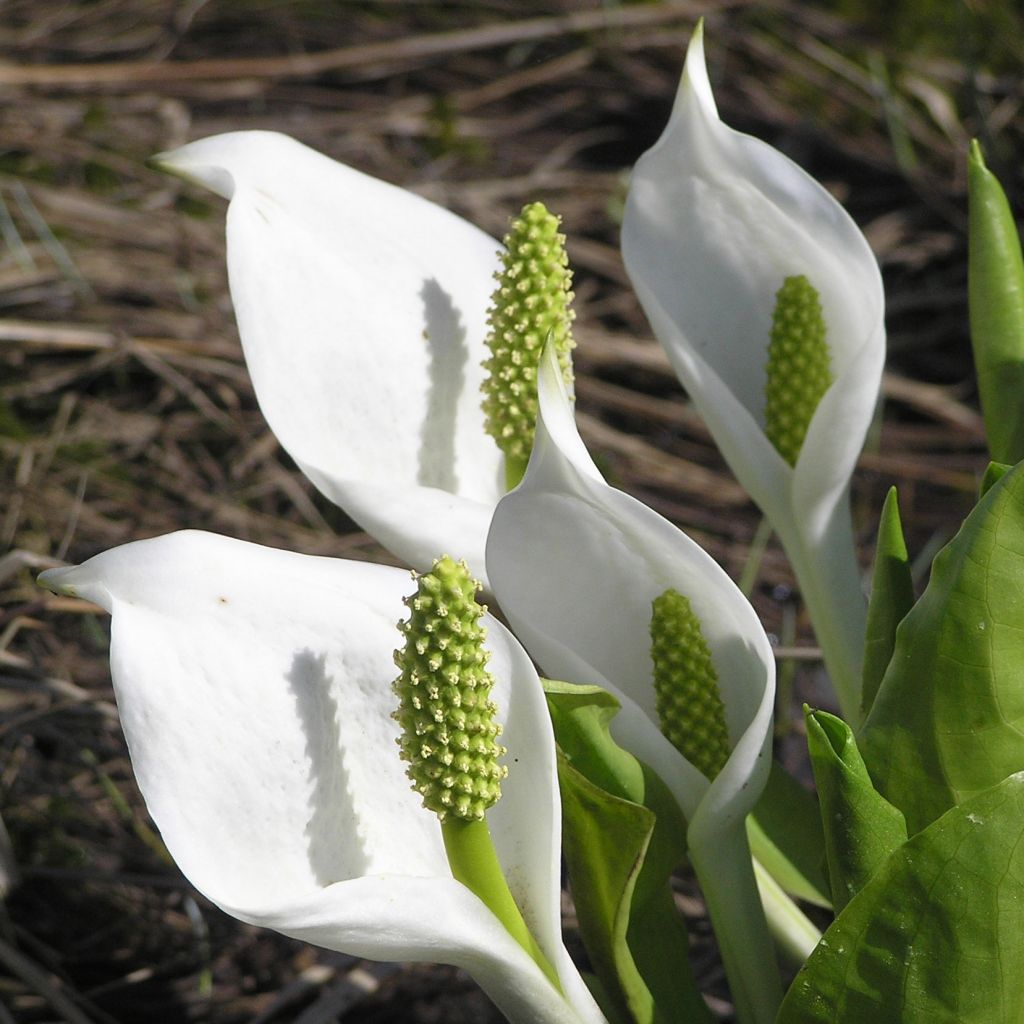

Lysichiton camtschatcensis


Lysichiton camtschatcensis
Lysichiton camtschatcensis
Lysichiton camtschatcensis
White Skunk Cabbage, Asian Skunk Cabbage
1 young plant ordered in a rooted bucket with 2 leaves as shown in the presentation photo. Planting upon receipt in a 10 cm (4in) gentle slope in a natural pond, near a rock. Good packaging. Waiting for the resumption.
Nathalie, 15/06/2021
Special offer!
Receive a €20 voucher for any order over €90 (excluding delivery costs, credit notes, and plastic-free options)!
1- Add your favorite plants to your cart.
2- Once you have reached €90, confirm your order (you can even choose the delivery date!).
3- As soon as your order is shipped, you will receive an email containing your voucher code, valid for 3 months (90 days).
Your voucher is unique and can only be used once, for any order with a minimum value of €20, excluding delivery costs.
Can be combined with other current offers, non-divisible and non-refundable.
Home or relay delivery (depending on size and destination)
Schedule delivery date,
and select date in basket
This plant carries a 12 months recovery warranty
More information
We guarantee the quality of our plants for a full growing cycle, and will replace at our expense any plant that fails to recover under normal climatic and planting conditions.
Would this plant suit my garden?
Set up your Plantfit profile →
Description
Lysichiton camtschatcensis, a very hardy cousin of arum, is a perennial plant found in marshes. It is particularly unique. It is highly decorative in a pond or along a riverbank. It also serves as support for unstable banks. It blooms in early spring, before the foliage emerges, with large pure white spathes that have a subtle musky fragrance. It is best reserved for medium to large ponds with extensive shores.
Lysichiton camtschatcensis belongs to the Araceae family. It originates from the northern region of Asia, with Kamchatka being the eastern tip of Russia. However, its distribution area includes the peripheral regions of Siberia and northern Japan. It is a slow-growing rhizomatous plant, with a rosette habit, reaching a minimum height of 60cm (24in) and a width of 50cm (20in). The flowering occurs in April-May-June as soon as the temperatures remain positive throughout the day. The white spathe surrounding a green spadix measures up to 10 to 12cm (4 to 5in) in length. It is almost odourless, but sometimes emits a slight musky fragrance. The elongated heart-shaped deciduous leaves have a medium to dark green lamina that is veined and very shiny. The rhizome of this aquatic plant is underground and creeping.
This hardy plant is suited for a cool climate. It withstands temperatures of at least -20°C (-4°F) in winter. It normally grows in moist to marshy soil and thrives ideally on the banks of a body of water or a stream. It is impossible to resist these giant arum-like flowers that create a fantastic atmosphere around the water feature that hosts them. Combine it with other bankside plants such as yellow-green spike rushes, Siberian irises with blue flowers, and European globe flowers with golden-yellow flowers. If the pond is very large, try planting it with Gunnera manicata.
Report an error about the product description
Lysichiton camtschatcensis in pictures


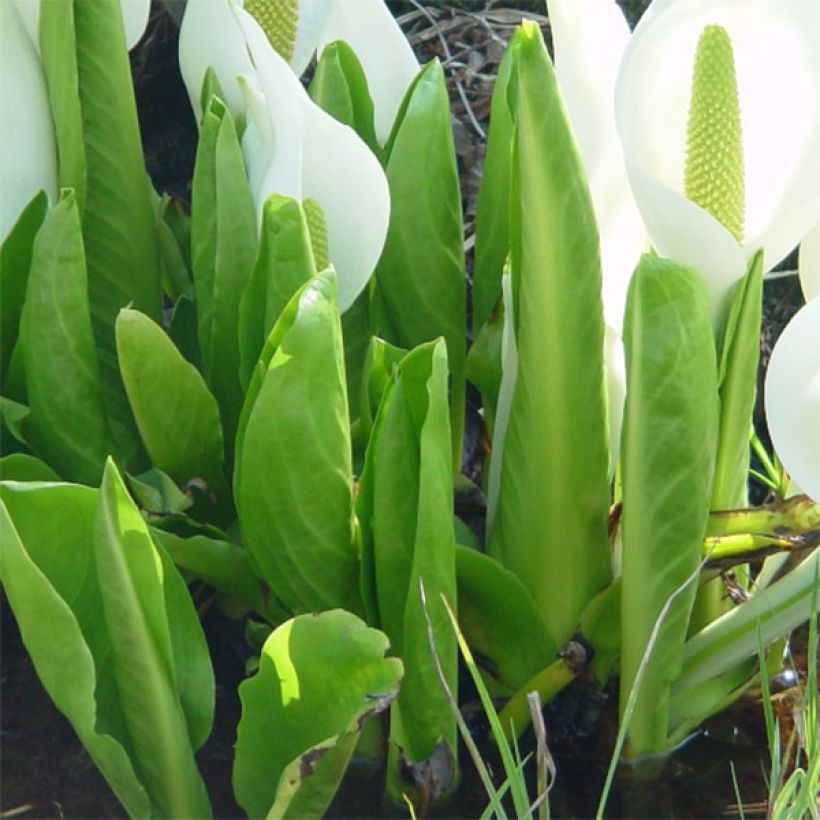

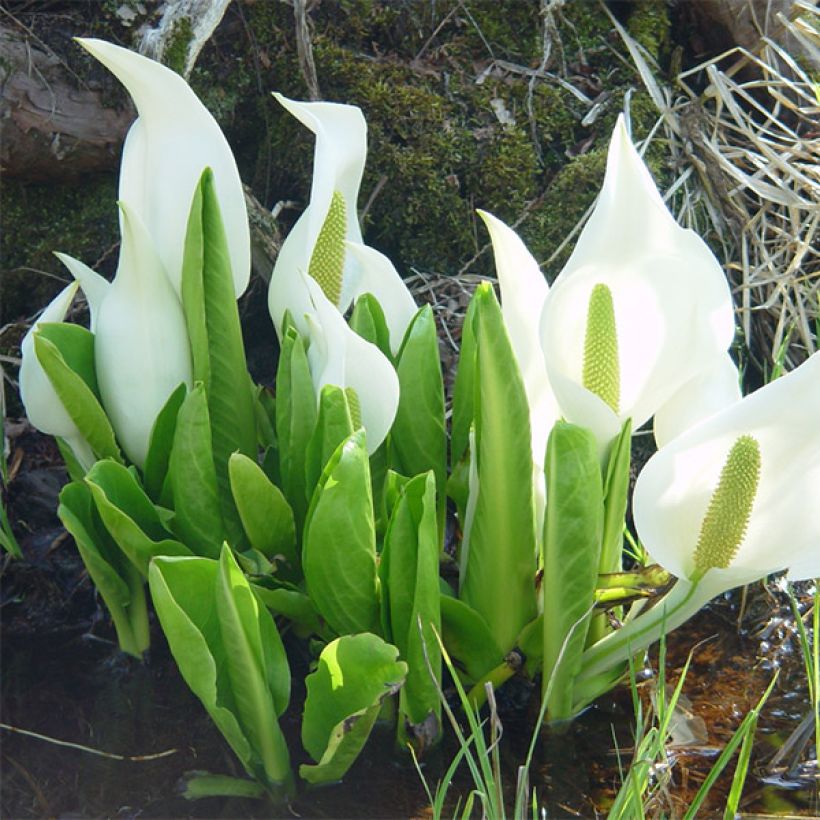

Flowering
Foliage
Plant habit
Botanical data
Lysichiton
camtschatcensis
Araceae
White Skunk Cabbage, Asian Skunk Cabbage
North Asia
Other Perennials A to Z
View all →Planting and care
Lysichiton camtschatcensis is a hardy perennial plant with a robust stump, but it grows very slowly. It takes at least 10 years of undisturbed cultivation to become spectacular. However, once established, your great-grandchildren will still enjoy it. This hardy plant is adapted to a cool climate. It can withstand temperatures as low as -20°C (-4°F) in winter. It normally grows in moist to marshy soil and thrives ideally on the banks of a body of water or a stream. Plant it from March to the end of May, in deep soil rich in organic matter, with a tendency towards acidity. Plant it deeply. Be careful when transplanting as the roots are fragile and brittle. It takes two or three years to establish itself. Choose a sunny or partially shaded exposure. Keep the soil moist if planting in open ground. You can also plant it in a pond, in water up to a maximum depth of 10cm (4in). Provide compost and turf, and use slug repellent for plants in open ground. This plant enjoys very wet soils, even temporarily submerged, in both summer and winter. This vigorous plant also needs space. Where the two species L. camtschatcensis and L. americanus grow together, a vigorous sterile hybrid with cream-coloured inflorescences can appear. Remove damaged or dying leaves before the winter period.
Planting period
Intended location
Care
Planting & care advice
-
, onOrder confirmed
Reply from on Promesse de fleurs
Similar products
Haven't found what you were looking for?
Hardiness is the lowest winter temperature a plant can endure without suffering serious damage or even dying. However, hardiness is affected by location (a sheltered area, such as a patio), protection (winter cover) and soil type (hardiness is improved by well-drained soil).

Photo Sharing Terms & Conditions
In order to encourage gardeners to interact and share their experiences, Promesse de fleurs offers various media enabling content to be uploaded onto its Site - in particular via the ‘Photo sharing’ module.
The User agrees to refrain from:
- Posting any content that is illegal, prejudicial, insulting, racist, inciteful to hatred, revisionist, contrary to public decency, that infringes on privacy or on the privacy rights of third parties, in particular the publicity rights of persons and goods, intellectual property rights, or the right to privacy.
- Submitting content on behalf of a third party;
- Impersonate the identity of a third party and/or publish any personal information about a third party;
In general, the User undertakes to refrain from any unethical behaviour.
All Content (in particular text, comments, files, images, photos, videos, creative works, etc.), which may be subject to property or intellectual property rights, image or other private rights, shall remain the property of the User, subject to the limited rights granted by the terms of the licence granted by Promesse de fleurs as stated below. Users are at liberty to publish or not to publish such Content on the Site, notably via the ‘Photo Sharing’ facility, and accept that this Content shall be made public and freely accessible, notably on the Internet.
Users further acknowledge, undertake to have ,and guarantee that they hold all necessary rights and permissions to publish such material on the Site, in particular with regard to the legislation in force pertaining to any privacy, property, intellectual property, image, or contractual rights, or rights of any other nature. By publishing such Content on the Site, Users acknowledge accepting full liability as publishers of the Content within the meaning of the law, and grant Promesse de fleurs, free of charge, an inclusive, worldwide licence for the said Content for the entire duration of its publication, including all reproduction, representation, up/downloading, displaying, performing, transmission, and storage rights.
Users also grant permission for their name to be linked to the Content and accept that this link may not always be made available.
By engaging in posting material, Users consent to their Content becoming automatically accessible on the Internet, in particular on other sites and/or blogs and/or web pages of the Promesse de fleurs site, including in particular social pages and the Promesse de fleurs catalogue.
Users may secure the removal of entrusted content free of charge by issuing a simple request via our contact form.
The flowering period indicated on our website applies to countries and regions located in USDA zone 8 (France, the United Kingdom, Ireland, the Netherlands, etc.)
It will vary according to where you live:
- In zones 9 to 10 (Italy, Spain, Greece, etc.), flowering will occur about 2 to 4 weeks earlier.
- In zones 6 to 7 (Germany, Poland, Slovenia, and lower mountainous regions), flowering will be delayed by 2 to 3 weeks.
- In zone 5 (Central Europe, Scandinavia), blooming will be delayed by 3 to 5 weeks.
In temperate climates, pruning of spring-flowering shrubs (forsythia, spireas, etc.) should be done just after flowering.
Pruning of summer-flowering shrubs (Indian Lilac, Perovskia, etc.) can be done in winter or spring.
In cold regions as well as with frost-sensitive plants, avoid pruning too early when severe frosts may still occur.
The planting period indicated on our website applies to countries and regions located in USDA zone 8 (France, United Kingdom, Ireland, Netherlands).
It will vary according to where you live:
- In Mediterranean zones (Marseille, Madrid, Milan, etc.), autumn and winter are the best planting periods.
- In continental zones (Strasbourg, Munich, Vienna, etc.), delay planting by 2 to 3 weeks in spring and bring it forward by 2 to 4 weeks in autumn.
- In mountainous regions (the Alps, Pyrenees, Carpathians, etc.), it is best to plant in late spring (May-June) or late summer (August-September).
The harvesting period indicated on our website applies to countries and regions in USDA zone 8 (France, England, Ireland, the Netherlands).
In colder areas (Scandinavia, Poland, Austria...) fruit and vegetable harvests are likely to be delayed by 3-4 weeks.
In warmer areas (Italy, Spain, Greece, etc.), harvesting will probably take place earlier, depending on weather conditions.
The sowing periods indicated on our website apply to countries and regions within USDA Zone 8 (France, UK, Ireland, Netherlands).
In colder areas (Scandinavia, Poland, Austria...), delay any outdoor sowing by 3-4 weeks, or sow under glass.
In warmer climes (Italy, Spain, Greece, etc.), bring outdoor sowing forward by a few weeks.






































